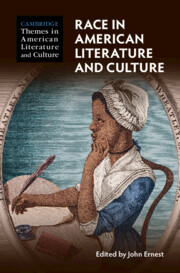Book contents
- Race in American Literature and Culture
- Cambridge Themes in American Literature and Culture
- Race in American Literature and Culture
- Copyright page
- Contents
- Contributors
- Acknowledgments
- Introduction
- Part I Fractured Foundations
- Part II Racial Citizenship
- Part III Contending Forces
- Part IV Reconfigurations
- Part V Envisioning Race
- Part VI Case Studies
- Chapter 19 Collective Biographies and African American History
- Chapter 20 Aztlan for the Middle Class
- Chapter 21 The Racial Underground
- Chapter 22 Literature in Hawaiian Pidgin and the Critique of Asian Settler Colonialism
- Chapter 23 Celeste Ng’s Little Fires Everywhere and the Burning House of American Literature
- Part VII Reflections and Prospects
- Index
Chapter 19 - Collective Biographies and African American History
Men of Mark (1887) and Progress of a Race (1897)
from Part VI - Case Studies
Published online by Cambridge University Press: 26 May 2022
- Race in American Literature and Culture
- Cambridge Themes in American Literature and Culture
- Race in American Literature and Culture
- Copyright page
- Contents
- Contributors
- Acknowledgments
- Introduction
- Part I Fractured Foundations
- Part II Racial Citizenship
- Part III Contending Forces
- Part IV Reconfigurations
- Part V Envisioning Race
- Part VI Case Studies
- Chapter 19 Collective Biographies and African American History
- Chapter 20 Aztlan for the Middle Class
- Chapter 21 The Racial Underground
- Chapter 22 Literature in Hawaiian Pidgin and the Critique of Asian Settler Colonialism
- Chapter 23 Celeste Ng’s Little Fires Everywhere and the Burning House of American Literature
- Part VII Reflections and Prospects
- Index
Summary
Collective biographies have played a major role in African American historical writing since the early nineteenth century. The essay explores two of the many African American collective biographies published in the last decades of the century: Men of Mark (1887) and Progress of a Race (1897). Produced during what Rayford Logan has called the “nadir” of race relations, they aimed at showcasing the achievements of African Americans and inspiring pride and emulation in black audiences. Their authors also vigorously denounced the current degraded situation of African Americans. Unlike Men of Mark, which clearly targeted a black readership, Progress of a Race, signed by two authors, one black, one white, attempted to reach a double audience of blacks and whites. The second part of the essay looks into the publishing history of the works, both of which were issued by white subscription houses, and examines the way they were promoted, marketed, and received. It raises intriguing questions as to the marketability and audience of works primarily aimed at an African American readership.
Keywords
- Type
- Chapter
- Information
- Race in American Literature and Culture , pp. 309 - 323Publisher: Cambridge University PressPrint publication year: 2022
- 1
- Cited by

